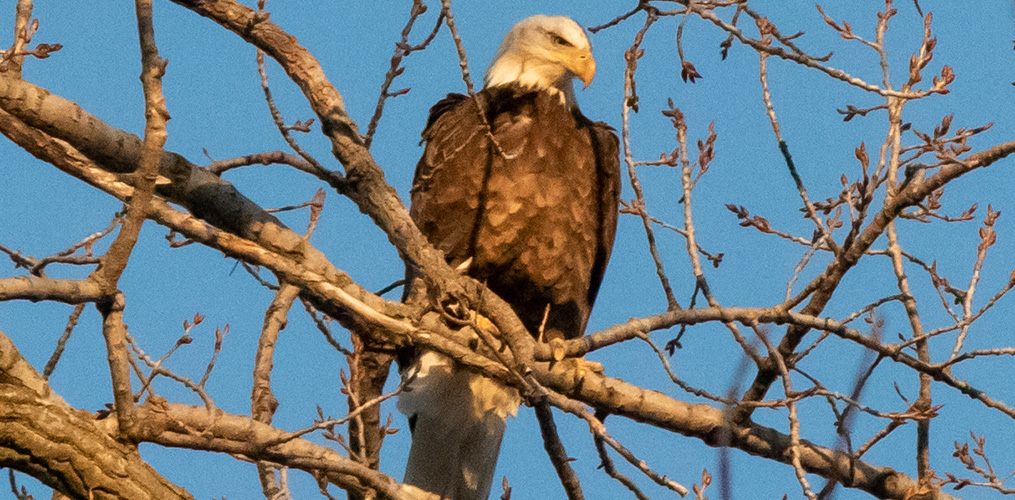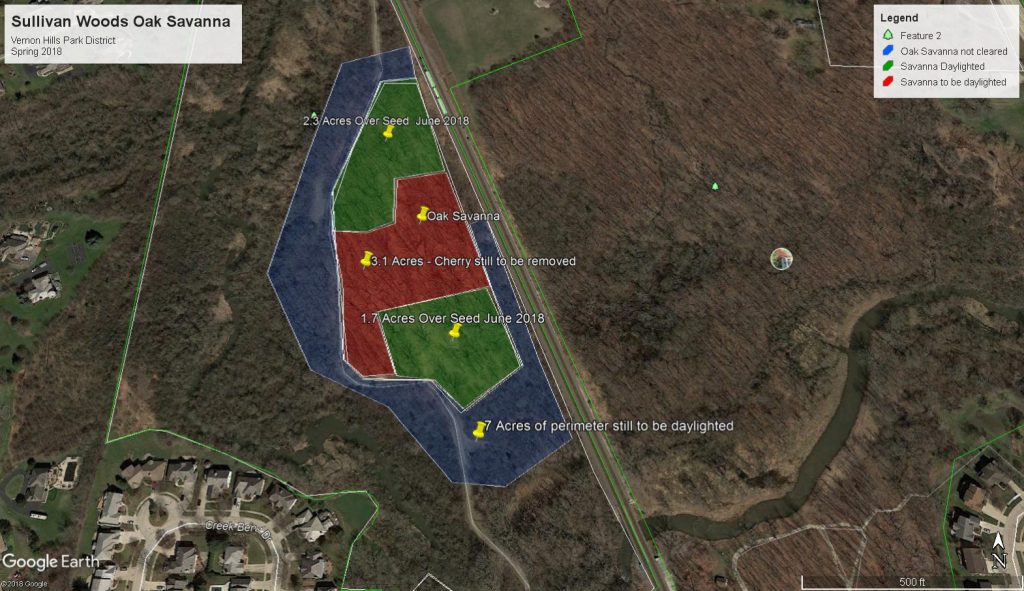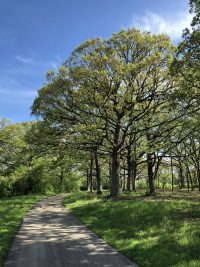Sullivan Woods Oak Savanna Restoration Update – May 2018
A very exciting thing has been happening in the Oak Savanna this spring, now that sunlight can reach the forest floor prairie plants that have been lying dormant for the last 30-40 years have started to come up and bloom. We had been hoping that there was a dormant prairie seed bed in the soil waiting for the right conditions to allow them to come back and it would appear that the work we have done has made this possible. Jack in the Pulpits, Wild Geranium, Prairie Onions, Sensitive Ferns, and many others are surfacing across the 7 acres. These are smaller plants with small blooms so please don’t expect a field of flowers when you visit there, new things are popping up weekly, feel free to wander through and take a look, but please do not pick or dig any up to take home.
This July will mark 2 years since we started the effort of restoring the 14 acre Oak Savanna. In July of 2016 we began clearing the middle 7 acres of invasive Buckthorn and Honeysuckle bushes along with hundreds of Black Cherry trees that invaded the once pure Oak stand. In the next couple weeks we will reach a milestone when we start spreading native prairie seeds across the northern 2.3 acres and southern 1.7 acres. The middle 3.1 acres still have Cherry Trees to be removed and will be ready for seeding next spring. Some herbicide treatments will be taking place throughout the year so you may notice some plants dying, they are invasive plants that were still working to eradicate.
As we approach completing the removal process in the middle 7 acres, plans to start clearing an additional 1 acre further south to liberate 3 huge Oak trees that we estimate to be over 300 years old along with many younger oaks that have established near them. Following this area we will move across the path and start clearing the outer edge of the savanna moving up to the north. We estimate the entire project will take at least 10 years in all.
Welcome to the Vernon Hills Park Districts oak savanna restoration at Sullivan Woods
Introduction
The Vernon Hills park district is dedicated to brining quality parks, recreational areas, and natural spaces to the community of Vernon Hills. In the spirit of this effort the Park District will be restoring Sullivan Woods to its natural state as an Oak Savanna. The many benefits this undertaking provides are described below, along with the history and ecology of Oak Savannas in the Midwest.
Sullivan Woods
Restoring an oak savanna at Sullivan Woods presents an opportunity to reestablish some of Illinois proud natural heritage. In the past Illinois was characterized by highly productive and ecologically diverse habitats. These savannas, wetlands, and forests in turn supported a rich variety of wildlife. Restorations like Sullivan Woods are important in helping local fauna to recover and maintain their populations in the face of threats such as habitat loss and disease.
Sullivan Woods has had a colorful past. Early records indicate that it had existed as an Oak Savanna for over 150 years. It was likely maintained in this state by Native Americans who used this region for hunting and grazing. When this region was settled by European migrants it was used for grazing and farming. Sullivan Woods was specifically used as a grazing area. While this period marked the transition of Sullivan Woods away from savanna the effort of hungry cattle helped maintain Sullivan Woods as a pure oak stand.
Eventually the farm property was sold and the Savanna was subjected to encroachment by the development of new homes, a period during which the value of the stand was overlooked. Without fire or grazing to help prevent their growth, trees not typically seen in an oak savanna grew in. Trees found alongside the oaks include Black Cherry, crabapple, Walnut, Boxelder, and Norway Maple. These new trees blocked light from reaching the native grassland plants which created an opening for fast growing, shade tolerant exotics such as honeysuckle and buckthorn. Removing this invasive understory became the first step the Vernon Hills Park District took when it began restoring Sullivan Woods.
A Special and Imperiled Ecosystem
The importance of Oak Savanna in the Midwest is a result of their unique ecological structure. Oak Savannas are transitionary ecosystems that primarily occurred along the borders of forests and prairie. They form naturally when stands of oak trees grow widely enough apart that a sun loving understory of grasses and forbs can develop. The combination of acorn production, woody habitat structure, and open grasslands attracts a variety of animal and insect life.
Frequent disturbances such as grazing or fire play a critical role in shaping the structure and ecology of Oak Savanna. Fire is of particular importance to the health of Oak Savanna. Periodic burns suppress the growth of fire intolerant trees and clears accumulations of plant and leaf matter. The dominance of Oak Trees in the over story is due to their quick growth as juveniles and resistance to fire as adults.
While lightning strikes sparked fires originally, Native Americans have been using periodic fires to actively manage the land for the past 10,000 years. Native American utilized fires to drive elk and bison in favorable directions while they were hunting. (Illinois state museum) Later European Settlers continued to burn parts of the area to create pasture but eventually abandoned the practice, instituting fire suppression measures at the turn of the 20th century. (Gowacki, Abrams, 2008) At the time of European Settlement oak savannas in the Midwest amounted to about 50,000,000 acres. A combination of fire suppression beginning in the early 1900’s and expansion of settlement caused acreage of Oak Savanna to dwindle down to a mere 30,000 acres. (OakSavannas.org) Without regular burning what remains is degraded and subject to colonization by invasive plants that do little to support local wildlife.
By reconstructing this habitat the Vernon Hills park district will be leading the way on utilizing local parks for the restoration of rare and imperiled ecosystems.
Benefits and Ecology
Oak Savannas provide valuable ecosystem services as well as providing various recreational benefits. The benefits to wildlife and conservation and the different ways residents can enjoy the Oak Savanna are outlined below.
Recreation
Oak Savannas provide beautiful leisure areas for park goers. To facilitate this value the park district plans to include a walking path and informational plaques. This will make Sullivan woods a great destination for joggers and residents in mind for a scenic walk.
Educational classes and groups for young kids such as little learners can utilize Sullivan Woods for field trips. Sullivan Woods will also be an excellent destination for bird enthusiasts looking to take advantage of the charismatic bird species nesting in the savanna.
Large Wildlife
The acorn production of Oak trees supports a variety of wildlife from small rodents to large game. Deer, grouse, and wild turkey will all potentially take advantage of the resources of the Oak Savanna. These animals will in turn experience predation by fox, coyote, hawks, and owls. While acorn production normally happens from year to year the removal of thick invasive brush from Sullivan Woods has made the understory of the trees more accessible to larger wildlife. Deer especially have been taking advantage of Sullivan Park in recent times, and their grazing activity has been helping to keep down the regrowth of some of the plants that the Park District removed in 2016.
Ecology
The primary reason for performing this restoration is that oak savannas are bastions of ecological diversity. The unique combination of open grassland and large trees leads to communities of plants found nowhere else outside of Oak Savanna. Plant communities form the bedrock of ecosystems in the Midwest and the structure of these communities has a huge influence on the kind of wildlife present.
For example there are several species of birds that have a close association to Oak Savanna. These birds prefer more open territory compared to closed canopy forest, but also require some woody habitat which expansive treeless prairies lack. Due in large part to loss of appropriate habitat up to 70 percent of these bird species are currently facing declining populations. (Hunter Et Al. 2001) Fire has been shown to improve reproductive success of birds and may benefit both savanna associated species and the more generalist species coexisting alongside them. (Brawn, 1998) (Hunter Et Al, 2001)
Oak Savanna also helps pollinators. Bee species, many of which are facing declining populations nationally from various ecological threats, are especially important beneficiaries of oak savanna restorations. It has been shown that the rich variety of savanna flowers supports a number of different bee species. Bee abundance also increases in areas with low canopy cover that experience periodic disturbances (Grundel et al. 2010).
As oak savannas are historically transitionary communities bordering forests and grasslands it has been found that these habitats are accustomed to fragmentation. This may mean that the benefits of restoring these ecosystems may be present even in smaller scale restorations such as Sullivan Woods. (Brawn, 1998)
Many plants and animals make up the community of an oak savanna, and the scarcity of this habitat makes it hard to predict what species will show up. This means that the restoration at Sullivan Woods is an exciting opportunity to provide a beautiful natural area to local residents while also contributing to the regional conservation of this once widespread ecosystem.
The Process of creating an ecosystem
In 2016 the understory of Sullivan woods was mowed down and a tremendous amount of invasive buckthorn and honeysuckle was removed. While this opened up the savanna considerably there remains a long road in restoring Sullivan Woods. Described below will be the steps the Vernon Hills Park District will take to restore the Sullivan Woods Oak Savanna.
2017
During the 2017 growing season there were multiple visits to the site to manage invasive and exotic weeds. These visits included activities such as mowing and selective application of herbicides. During the fall and winter non oak trees were cut down and burn piles were created. A burn permit was acquired from the Illinois EPA to allow for the burning of piles of logs consisting primarily of Black Cherry and Boxelder Trees.
2018
Park District crew will be sent to manage invasive garlic mustard. Other weeds that may be managed throughout the year include; Burdock, lettuce sp., thistles, grapevine, oriental bittersweet, reed canary grass, sweet clover, ragweed, and brambles.
During the fall of 2018 a controlled burn will be performed at Sullivan woods. This burn will cull invasive species and fire intolerant species that are undesirable in an oak savanna. The date of this burn will be determined by weather and field conditions.
In the winter of 2018/2019 the park district will install a native seed mix. Seeding in the winter will expose the seeds to cold spells that stimulate the seed to break its dormant stage, allowing the seeds to germinate in the spring. This process is called stratification. Forbs will be planted initially, followed by grasses. Grasses grow more quickly than forbs, which is why forbs need an opportunity to begin germinating before they face competition from native grasses.
2019 and Beyond
Further burns will be required in 2019 and possibly 2020 to establish a robust Oak Savanna. In addition to controlled burns exotic species may be controlled by weeding and herbicide application. After 2020 burning will be done periodically every 3-5 years to maintain the health of the Savanna.
To the Future
The Oak Savanna restoration at Sullivan Woods is still in its beginning stages. The underbrush of invasive Buckthorn and Honeysuckle has been removed and the weeds have been treated with herbicide. The next step for this restoration is to cut down and remove non-oak species of trees followed by seeding a native plant community. An important step for this process is to perform periodic burns which creates a natural disturbance cycle and helps the natural community establish itself. Management of the site through burning and brush control will give the park district its best chance at creating a healthy and diverse savanna. (Lettow et al. 2014)
Once restored the park district would like to include a walking path and descriptive plaques so that park goers can enjoy the full beauty of the savanna. After the savanna is firmly established the park district would also like to expand its borders to liberate the oaks on the edges of the project that are still swamped with weedy invasive species.
The restoration and year to year maintenance of the Sullivan Woods Oak Savanna also provides an excellent opportunity for volunteers and community members hoping to get involved in citizen science. In order to properly tackle the huge challenge of monitoring species diversity across Illinois, conservation scientists make easy to follow protocols available for free to any interested volunteers. The valuable data collected from these efforts is uploaded into databases used by scientists to monitor diversity across Illinois.
At this time the Vernon Hills Park District, in partnership with the Bird Conservation Network, would like to perform bird diversity surveys in the Savanna. These surveys will occur twice in June during the breeding season. Each survey will be open to the public. If the program is popular more surveys will be offered throughout the year.
Other monitoring programs the park district may offer in the future include photographic monitoring of bees in the park and butterfly censuses. Any members of the community interested in helping the park district expand its monitoring efforts are encouraged to volunteer. No matter the species targeted, it is the hope of the park district that the Savanna will serve as a tool for education and conservation.
The process that the Vernon Hills park district goes through with this project can serve as a blueprint for future oak savanna restorations, including by other park districts. As stated previously the naturally fragmented nature of oak savanna ecosystems may mean there is value even in small scale restoration; which combined with the dwindling acreage means that park districts should give careful consideration to restoring oak savanna fragments in the future.
Bibliography
William CH et al. 2001. Conservation of disturbance-dependent birds in eastern North America. Wildlife Society Bulletin. Volume 29 Number 2.
Brawn Jd. 1998. Effects pf Oak Savanna Restoration on Avian Populations and communities in Illinois. Center for Wildlife Ecology.
Grundel R et Al. 2010. Floral and Nesting resources, habitat structure, and fire influence bee distribution across an open forest gradient. Ecological Applications, 206 pp. 1678-1692
Lettow MC. Et al. 2014. Oak savanna management strategies and their differential effects on vegetative structure, understory light, and flowering forbs. Forest Ecology and Management 329 89-98
Oak Savannas; Characteristics, Restoration, and Long-Term Management: [accessed 2017 Aug 17] https://www.oaksavannas.org/geography.html
Illinois State Museum: Museum Links, Prairie Ecosystems. Copyright © 2000 Illinois State Museum [accessed 2017 Aug 17] Ecosystems https://www.museum.state.il.us/muslink/prairie/htmls/intro.html



